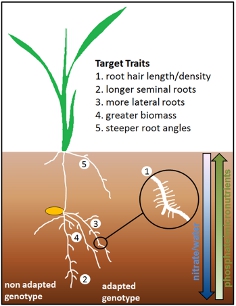About us
Contents
X-ray Computed Tomography (CT)
X-ray Computed Tomography (CT) is a non-invasive, non-destructive imaging technique permitting the visualisation and quantification of the interior structure of an object in three dimensions. Its key principal is based on the attenuation of X-rays as they interact with the constituent materials of a sample. A series of radiographs (similar to such taken by a doctor to diagnose a broken limb) are recorded at a series of angular positions over 360º and are subsequently reconstructed using mathematical algorithms to give three dimensional volumetric data. This data can be visualised in a virtual cross sections (slice by slice nature) giving high resolution spatial maps of X-ray attenuation which is related to material density of the sample.
The X-ray CT technology provides high resolution 3D images of the internal structure of a wide variety of objects, materials and environments. Those images are rich sources of information about the scanned samples, showing the structure of and boundaries between different material types. Accurate measurement of sample properties, however, can be challenging. Image processing and analysis tools are required which can recover the required information from large and complex CT images. The development of novel image analysis techniques and software is an active area of research within the Hounsfield facility.
The Hounsfield Facility
The Hounsfield Facility is based within the School of Biosciences at the Sutton Bonington campus. Opened in 2014, it houses state-of-the-art X-ray CT equipment integrated with automated robotics. This enables scientists to explore the internal architecture of biomaterials and support research into environmental sustainability and global food security. A particular focus is rhizosphere research into microscopic root-soil interactions.
Our building is named after the inventor of X-ray CT, Sir Godfrey Hounsfield who once said: “Each new discovery brings with it the seeds of other, future inventions. There are many discoveries, probably just around the corner, waiting for someone to bring them to life. Could this possibly be you?” That message resonates in our building.
Rhizosphere research
The Rhizosphere
The Rhizosphere is the dynamic zone surrounding plant roots growing in soil and has significant impact on the ability of a plant to capture both water and nutrients. This biophysical interface between root and soil is a highly complex and diverse biotic community consisting of a multitude of bacteria, fungi, nematodes, invertebrates etc). Understanding these interactions is very important with respect to issues such as maximising inputs from the available land and potential issues associated with its degradation. With a rapidly increasing global population and the threat of a changing climate, maximising plant productivity and developing sustainable soil management strategies are vital for food security.
Improving our knowledge of the Rhizosphere
 Plant root architecture critically influences nutrient and water uptake efficiencies. However, our knowledge about the genes that control root growth in the rhizosphere (i.e. soil environment) is currently limited. For example, rooting depth impacts acquisition of nutrients and water If we can identify and manipulate the genes that regulate key root architectural features – such as angle, depth and density - water and nutrient uptake could be improved which would positively impact on yield.
Plant root architecture critically influences nutrient and water uptake efficiencies. However, our knowledge about the genes that control root growth in the rhizosphere (i.e. soil environment) is currently limited. For example, rooting depth impacts acquisition of nutrients and water If we can identify and manipulate the genes that regulate key root architectural features – such as angle, depth and density - water and nutrient uptake could be improved which would positively impact on yield.
Rhizosphere research at The Hounsfield Facility
Using X-ray µCT we are undertaking work on phenotyping the entire plant (leaf, shoot, root and the soil) to gain a comprehensive understanding of all of the key crop architectural features - above and below ground. Such a depth of knowledge is needed for screening novel crop varieties in order to determine exactly which combination of root and shoot architectural features are necessary to confer improvements to yield and water/nutrient uptake. The ability to quantify root and shoot shape will also enable us to pinpoint the genes that control these traits and facilitate the genetic manipulation of equivalent traits in other crop species.